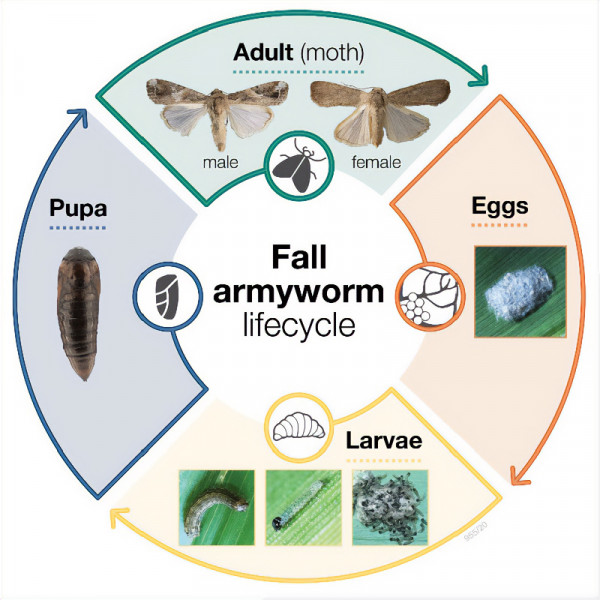Managing the plant pest fall armyworm
5 May 2022

Fall armyworm lifecycle - view the identification sheet below.
Last month, Biosecurity New Zealand confirmed that a single fall armyworm egg mass has been found in Tauranga.
Process Vegetables New Zealand, Vegetables New Zealand, Onions New Zealand and other industry groups are closely engaged in the fall armyworm response, alongside other GIA partners Seed and Grain Readiness and Response, and the Ministry for Primary Industries.
Further information will be provided on options for addressing fall armyworm, but in the meantime the focus is on identifying the spread, reporting any possible finds, and dealing with any confirmed populations.
Managing the plant pest fall armyworm
Biosecurity New Zealand and primary sector partners are continuing to respond to the discovery of the fall armyworm and want to thank all farmers and growers for keeping an eye out and reporting signs of this moth pest.
While the fall armyworm thrives in very warm climates and it is unlikely to survive winter in most areas of New Zealand. Growers are encouraged to continue to look for signs of it, particularly on volunteer maize and corn plants. Information about this pest and what to look for can be found here.
It can easily be mistaken for other species so if you suspect fall armyworm, take a photo (caterpillars at least 2cm long) and call Biosecurity New Zealand’s Pest and Disease Hotline (0800 80 99 66) or report online at report.mpi.govt.nz/pest. Alternatively, you can report via the Find-a-Pest app.
There has been a great response so far from those asked to check their crops, with more than 75 calls to Biosecurity New Zealand’s pests and diseases hotline. Thank you to those farmers and growers who are playing their part in this.
Click here for a fall armyworm identification sheet
Click here for a fall armyworm factsheet
North Island growers
There have been some isolated detections of this pest in five regions so far – a single egg mass in Tauranga and larvae in paddocks near Hamilton, in South Auckland, Waitara and Gisborne. The detections support MPI’s risk analysis last year that found the pest was likely to arrive on storm fronts across the Tasman.
Biosecurity New Zealand has had people on the ground checking paddocks in areas where we’ve found the pest, talking to growers and collecting samples, and staff will be available for ongoing support as required.
There are actions people can take to manage fall armyworm if it is found on their property.
South Island growers
Growers and farmers in the top-of-the South Island should keep a look out for fall armyworm, despite the lower chance of the pest being there.
Management options on site for places where it is found in maize/sweetcorn can be
If you suspect you have found a fall armyworm, take a photo (caterpillars at least 2cm long) and call Biosecurity New Zealand’s Pest and Disease Hotline (0800 80 99 66) or report online at report.mpi.govt.nz/pest.
If you have it in your volunteer crop coming through:
- Herbicide spray the volunteers with any herbicide you have in the shed followed by tilling to a minimum 10cm depth, or;
- Spot spray the volunteers with insecticide (ideally diamides or spinosyns/spinosoids), or;
- Hand pull the volunteer plants and securely dispose them if there are small numbers;
- Mowing or intensive grazing the field with the volunteer plants to remove the host material and starve the caterpillar, and;
- Think about rotation into a different crop for next season
If you have a whole field planted with maize or sweetcorn:
- Harvest the field for silage/balage and ensure the bulk host material is removed from the site and take steps to manage any volunteer crop coming through as per the above.
